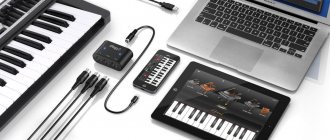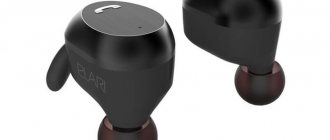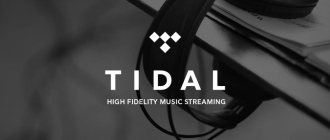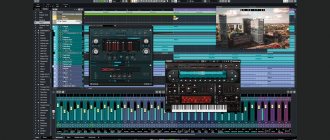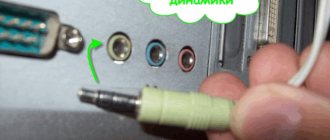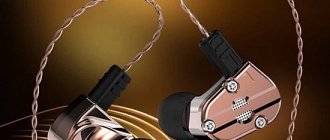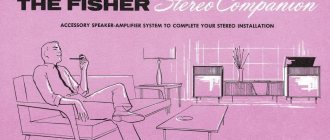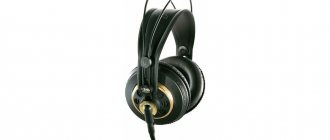The fact that now not a single recording studio can do without a computer, I think, is unnecessary to say. Even those studios that carry out analog recording on tape recorders (and, believe me, there are still some), still use computers, including to control the same tape recorders.
Therefore, today a computer is an important and integral component of any recording studio, both home and professional.
Not only the convenience of work, but also its quality depends on the computer, no matter how strange it may seem at first glance. For example, if the computer is too noisy, all this noise can get into your recording, and it’s no secret how this will affect the recording.
Or, for example, if the computer has insufficient performance, this will significantly limit your ability to use various resource-intensive programs, applications and plug-ins. And high-quality audio processing now requires more and more resource-intensive software.
And we should also talk about reliability - a studio computer should under no circumstances let you down at a crucial moment. Therefore, its assembly must be approached with great responsibility, especially if studio activity is your profession.
In this article I will talk in detail about how to build a good, productive computer for recording and working with sound, which will become your reliable workhorse for several years to come.
This article will only talk about the computer; choosing a sound card is the topic of a separate article.
I’ll say right away that the article will focus on PCs; we will not consider Apple computers.
I will also say that I am a professional sound engineer, but I am not a specialist in computer technology, so everything that I will talk about in this article is based on my personal experience.
And of course, I understand perfectly well that computers become obsolete extremely quickly, so I update this article once a year, in accordance with updates and innovations in the computer industry. So the article will always be relevant, because the general principles of choosing a PC over the years, as my experience shows, do not fundamentally change, changes concern only numbers and names.
Before you assemble a studio computer, you need to clearly understand what exactly you will do on it. Just one clear answer to this question can already help you save a lot of money.
For example, if you plan to record “demos” of vocals for backing tracks, then this is one thing; if you want to write soundtracks for films, then this is another; if you want to record acoustic drums, then this is a third.
Different types of work require different computer performance, and therefore, if you need to record vocal/guitar “demos” without any special processing, then there is no need for any particularly powerful PC - almost any not very old household computer can handle this task .
At the same time, if we are talking about a studio where multi-channel recording is planned, and/or the creation of large-scale musical compositions with an abundance of instruments, effects and processing, then at least a non-home computer will be required.
Therefore, decide for what purpose you need a computer and what exactly you will do on it. This will help you choose the best option in terms of price/performance ratio.
Well, let's go!
CPU
I'm used to starting assembling a computer with the processor. It’s not for nothing that you can hear “A computer based on a processor...” The processor is the main component of productivity, so we need to start with it.
I don’t want to start a “AMD vs. Intel” holivar now, but from my personal experience I have repeatedly been convinced that Intel processors show significantly better performance when working with sound than AMD processors. With equal characteristics, of course. AMD attracts with its price, but personally, having tried both processors, I realized a long time ago that processors from Intel are much more expensive for a reason.
The whole point, apparently, is to optimize modern software for working with sound and music specifically for processors from Intel, which show noticeably better performance here than processors from AMD.
So, which processor should you choose for your studio computer?
Minimum.
If we are talking mainly about recording vocals, solo instruments and mixing small projects, then any 4-core processor of the Intel Core i5 family will be enough. In this case, it will definitely be enough.
Golden mean.
If you plan to engage in more serious mixing of multi-channel projects, and even more so in arranging and creating music, then Intel Core i5 should already be considered as the minimum option. In this case, the optimal choice would still be to choose a processor from the older family - Intel Core i7. Undoubtedly, these processors are not cheap, but they will provide performance that is enough to solve the vast majority of tasks.
Ideal.
But if finances allow, then you should look towards the Core i9 line, among which there are even 18-core monsters. True, the cost of these monsters is simply astronomical, so it’s worth considering whether it would be better to invest this money in some kind of audio equipment rather than in additional processor cores.
By the way, the processor should be selected in the OEM version, that is, without cooling, without a cooler - the cooling system must be purchased separately.
There's no need to chase the cores either. Look more at the clock speed (from 3500 MHz per 1 core), as well as the ability to overclock to higher values (up to 5000 MHz and above).
Which computer is best for making music?
If you're making the jump from a laptop to a desktop music studio, you're lucky to have a lot of choice about which direction you go. In one corner you have the world of gaming PCs, which deliver huge specs and the promise of easy upgrades in the future. In the next corner are all-in-one machines that are just as comfortable handling huge spreadsheets and email chains. In addition, there are unearthly “professional” models that are inaccessible to most mortals, but in themselves they already cause exciting admiration and trembling of hands.
Ruble for ruble, but there is a clear winner. The Dell XPS 8930 offers the perfect balance of price, performance and power, without ostentatious gaming trappings such as RGB lights or harsh graphics. This is a smart desktop computer that will serve you for years to come.
Motherboard
I will not analyze the technical intricacies of motherboards, because, as I already said, I am not a computer geek. But I will draw your attention to some important points.
At the very least, do not underestimate the importance of the motherboard, at least because the performance and stability of the entire computer largely depend on it.
Convenience is also important, so you should make sure that the board has all the necessary connectors in the required quantity, so that later you don’t find out that you have nowhere to connect a sound card or some connector turns out to be the “wrong” one.
As for manufacturers, there are few of them here, and among them ASUS and GIGABYTE have long established themselves as the most reliable. I will recommend them to you.
Yes, I’ll say right away that I only consider boards of the Standard-ATX form factor.
Minimum.
For Intel Core i5 processors, a decent option would be, for example, ASUS H410M-K or GIGABYTE H410M H.
Golden mean.
For Intel Core i7, the same models as for i5 are suitable, but it’s better to take something older like ASUS ROG STRIX B360-H GAMING or GIGABYTE Z390 UD, at least because they contain 4 slots for RAM chips memory.
Ideal.
But if you do shell out for a Core i9, then it’s better not to skimp on the motherboard and buy something decent. Let's say GIGABYTE Z390 AORUS ELITE or ASUS PRIME Z390-A.
DVD drive
In principle, this is not such a critical unit, but there are still recommendations. For example, Plextor is an excellent drive (people who work with sound value it because, although it costs more, it is capable of long-term trouble-free operation (for example, cutting 20 blanks in a stream one by one) and the likelihood of making mistakes when recording - much less. In principle, if you are not going to cut a lot of blanks, you can take any standard drive. But if you have to cut a lot of blanks, choose Plextor! If you need a Blu-Ray writer, I advise you to take the Pioneer S06 - no complaints, it practically writes blanks without errors (it was tested). https://www.nix.ru/autocatalog/blu_ray/BDR_RE_DVD_RAM_DVD_Pioneer_BDRS06XLB_Black_SATA_113105.html The latest price in Nix is 3800 rubles.
Video card
Now, if we talk about savings, then this is probably the only component in the entire configuration on which, in our case, we can save.
Working with sound is nothing complicated in terms of graphics, so all you need a video card for is connecting the system unit to the monitor.
Buy any modern video card with 2-4 GB GDDR5 memory from a trusted manufacturer like ASUS, GIGABYTE or MSI and don’t bother.
You don’t have to purchase an additional video card at all if the processor has a graphics core. However, I would still not recommend doing this, because the graphics core will take over part of the RAM, which can negatively affect the overall performance of the system.
On the other hand, no video card = no additional noise source. At least most modern video cards are cooled by fans, and under load they (the fans) can be very noisy. This must be taken into account if silence is of paramount importance to you.
Well, take care of the possibility of connecting an additional monitor (or better yet, two if you plan to use them at work). By the way, looking ahead, I would highly recommend this.
Ocenaudio
Ocenaudio is a lightweight, cross-platform audio capture and processing application. The software is available for all major operating systems: Microsoft Windows, Mac OS X and Linux. At first, the interface may seem complicated, but in general, using the software is convenient and does not cause difficulties. A distinctive feature is real-time preview of effects and sound recording from a sound card.
To speed up editing of complex audio files, the audio editor allows you to select parts of the audio file and listen, edit, or apply effects.
Pros:
- preview of applied effects;
- Wide support for various operating systems.
Minuses:
- complex interface.
Ocenaudio program interface
Frame
It's surprising that very few people pay much attention to the body. But this is a very important component. The computer case is, first of all, its cooling, which determines not only performance, but also durability. And also the housing also means noise, which, with the right choice, can be significantly reduced.
The first piece of advice I'll give you is: don't buy cheap Chinese junk.
The desire not to spend too much is, of course, understandable to me, but you also need to understand that a computer for professional work with sound is not something on which, in principle, you should save.
The housing must provide good air circulation, as well as reliable insulation from dust. Well, sound insulation is also an important point. But first things first.
The case is the component when choosing which you should often focus mainly on price, because the same manufacturer can produce both cheap and completely ugly and expensive high-quality models.
However, manufacturers such as CoolerMaster, Thermaltake, Be Quiet or, for example, Fractal Design produce mostly high-quality models. Therefore, almost any case from these companies that has suitable parameters can be purchased with confidence.
As for the standard size, a Midi-Tower will be enough for a home studio - this is a standard-sized system unit. It makes sense to take a Full-Tower, but only if you plan (even in the future) to use a large number of internal boards and hard drives.
Minimum.
Of the affordable options, I can recommend something like Aerocool Shard, CoolerMaster K280, Thermaltake Versa N27 or Deepcool Tesseract SW-RD.
Golden mean.
As a middle ground, Thermaltake Core G21, CoolerMaster MasterBox MB500, Fractal Design Meshify and Be Quiet PURE BASE 600 would be good options.
Ideal.
But ideally, if you are building a truly high-performance machine, it is better to buy a Full-Tower like the CoolerMaster TROOPER, Corsair Obsidian Series 750D or Be Quiet DARK BASE 900. Yes, expensive. But reliable, spacious and functional.
And yes, the case should be taken without a power supply; the power supply must be selected separately, which we will talk about later.
power unit
Many people completely underestimate this seemingly insignificant element. And in vain. Anyone who has ever had a power supply burn out, killing everything that was powered by it, now knows that you definitely can’t skimp on a power supply.
Of course, even the best power supply will fail sooner or later, but it is better for this to happen in 8-10 years and without consequences, and not in six months, taking with you a bunch of other components “to the next world.”
The main characteristic of a power supply is its power, which you first need to look at. Of course, the option “the more powerful, the better” is logical on the one hand, but on the other hand it is not universal. Still, we understand perfectly well that as the power of the power supply increases, your electricity bills will also increase, so the power supply should be selected according to the principle of sufficiency, but with some margin.
You can, of course, get confused and, using a calculator that is easy to find on the Internet, calculate the optimal power taking into account the needs of the selected components. Or you can just follow my recommendations and not bother.
1. Power
For an inexpensive budget computer based on Intel Core i5, a power supply with a power of 500-600 watts is sufficient. But for a more or less serious machine, it is better to consider power supplies with a power of 700 watts and higher.
But I repeat that a power supply should always be taken with a decent margin, because its real power in reality is almost never equal to the declared one. The power of the power supply must be at least one and a half times higher than the total power of all computer components. That is, if the total maximum power consumption of all computer components is 500 watts, you should consider power supplies with a power of 750 watts or higher.
2. Energy saving
Considering the fairly high power consumption of a computer power supply, the issue of energy saving worries many. Therefore, when choosing a power supply, you should pay attention to its compliance with one of the special certification levels “80 PLUS”.
The presence of such certification on a power supply indicates that its efficiency is at least 80% (depending on the load relative to the rated power).
There are several levels of certification (Bronze, Silver, Gold, Platinum, Titanium) and efficiency requirements increase with increasing levels. Therefore, the higher the level of certification, the more efficient the power supply will be in terms of energy consumption. Well, as you understand, this will affect the cost of the power supply accordingly.
Minimum.
For a budget computer that does not stand out with special performance, you can choose 500-600-watt power supplies like Be quiet! System Power 9, AeroCool KCAS PLUS or, for example, Chieftec GPE-500S. All of them are 80 PLUS Bronze certified.
Golden mean.
As a strong mid-ranger for a fairly powerful computer, you can pay attention to such options as Chieftec GPS-750C, Thermaltake Toughpower Grand RGB Gold, Corsair RM750x or Deepcool DQ750ST. All are 750 watt and gold certified.
Ideal.
For high-performance machines, you should look towards even more powerful and energy-efficient power supplies like the Corsair HX1000 or Thermaltake Toughpower iRGB.
Also, in order to reduce the overall noise from the system unit, look at the maximum noise produced by the power supply, which is usually indicated in the specifications in dBA. The lower it is, the better. Quiet power supplies include those whose noise does not exceed 20 dBA.
Some expensive power supplies have a smart cooling system - the fan only works when the temperature rises to a certain value, and the rest of the time cooling occurs passively.
There are even fanless power supplies that use only radiators to dissipate heat. It is clear that they work completely silently. However, only a passive cooling system can be effective for low-power power supplies with a maximum power of up to 500-600 watts. A passive system simply cannot effectively cool a more powerful power supply.
Finding the optimal point in the room
You need to decide where you plan to place your workplace. There are points in any room where music sounds better. There are also reverse points where the sound becomes much worse. For this reason, the first thing to do is understand what the room sounds like.
An acoustically poorly treated room will be a bad place to work from day one. In the cost estimate for equipment, you need to include a budget not only for the hardware itself, but also for the finishing of the room
Pyramid acoustic foam
Acoustic finishing with pyramidal acoustic foam panels is ineffective. They will have a slight improving effect, but the spectral region in which they operate does not allow the use of such panels with maximum efficiency. Don’t live in dreams that you can cover the entire room with foam rubber and everything will be cool.
Once you find yourself in a potential workspace, do the following:
- Call your boyfriend or girlfriend
- Take any powerful sound source (monitor, wireless speaker)
- Give the sound source to a friend
- Ask a friend to move around the space with the sound source
- Listen to which places the sound will be timbre better, cleaner, clearer and more pleasant
Most likely there will be several such points. Mark these places - here you will place your working sound source.
CPU cooling system
Of course, by cooling system, first of all, we mean the processor cooling system, although it is not limited to it.
The age-old question: cooler or water system?
The second is considered by many to be the best option, while the first option is much cheaper.
In fact, there is no magic in a water cooling system. A properly selected cooler can provide sufficient cooling even for a very hot processor.
What should you pay attention to?
The first thing you should pay attention to when choosing a processor cooler is its compatibility with your processor (or rather, with the socket) and, what many often overlook, with the case you choose.
The fact is that a good efficient cooler often turns out to be so large that it may not physically fit into the case. Therefore, when choosing a case, you should look at the maximum height of the cooler that can be installed in it, and when choosing a cooler, accordingly, at its dimensions.
It’s also not worth saving on a cooler, especially if you plan to frequently load the processor, and even more so if you plan to overclock the processor.
For the most efficient cooling, choose a copper or copper-aluminum cooler with at least four heat pipes. The maximum power dissipation of the cooler must necessarily exceed the power of the processor you choose.
Also, an integral part of any normal cooler will be a fan. He may not be alone.
As you know, any fan is a source of noise, so the choice of processor fans in particular and the entire system unit as a whole should be taken with full responsibility.
When choosing fans, pay attention to the following points:
- The maximum fan noise level should ideally not exceed 15-20 dB.
- Look at the maximum airflow, which is indicated in the CFM. The higher this value, the higher the cooling efficiency will be. True, in this case, as a rule, the noise generated by the fan will be louder.
- The less revving the fan is, the less noise it will make when rotating. Therefore, choose those fans that are the least revving if the noise issue is very acute. But remember that the lower the fan speed, the lower the air flow and, accordingly, the less heat it removes, due to which the cooling efficiency decreases. Here we need to look for a compromise.
- The larger the diameter of the fan, the lower the number of revolutions per minute it produces and, accordingly, the less noise it makes. Therefore, a large fan will always be quieter than a small one, provided that both remove the same amount of heat.
- Pay attention to the type of fan bearing: the quietest ones are bearings with magnetic centering. But there are also quite quiet models with a plain bearing or its improved version - a hydrodynamic bearing.
- Give preference to fans with a 4-pin PWM connector. At the very least, there must be at least one of these on the processor cooler. Connecting with a 4-pin PWM connector will allow the system to automatically control the fan speed depending on the load on the processor. As a result, at a low load level, such a fan will spin more slowly and make much less noise.
In addition to the fan on the processor cooler, there should be at least a couple more fans on the case, one of which will take air in from the front, while the other, located on the back of the case, will pull it out on the contrary.
So, what CPU coolers can we recommend?
Minimum.
As an inexpensive and at the same time low-noise cooler, we can recommend, for example, Deepcool GAMMAXX 300 and Zalman CNPS9X Optima as very reliable, low-noise and affordable options.
Golden mean.
For more efficient cooling, it is better to take an option like the Thermalright Le GRAND MACHO RT or the dual-fan Scythe Ninja 5 - yes, perhaps expensive for the golden mean, but very quiet and efficient.
Ideal.
As an unconditionally good option in terms of cooling efficiency, you should look towards the proven Noctua NH-D15 or Thermalright Macho X2.
It's especially worth mentioning the importance of cooling some AMD processors, which are notorious for running extremely hot. If you decide to build a computer on AMD, then you definitely shouldn’t skimp on the cooler.
Well, we cannot help but say that if you plan to overclock the processor, the requirements for the cooler immediately increase, since the overclocked processor requires significantly more cooling.
Look primarily at the power dissipated by the processor and choose a cooler whose maximum power dissipation (TDP) is at least equal to that specified in the processor specifications.
RAM
This is one of the most important components of a computer for working with sound. RAM is especially important for those who plan to work with samplers and other virtual instruments based on sound libraries. Here, the volume and speed of RAM are of utmost importance, since a lack of them will immediately significantly limit your capabilities.
You should start choosing memory by choosing a type that is selected in accordance with the motherboard. Today, it seems to me, we should consider the DDR4 standard, which, unlike its predecessor DDR3, doubles the maximum data transfer rate to 3.2 Gbps and the maximum frequency to 4266 MHz.
The second thing is volume.
Minimum.
Today, it’s probably not worth considering buying a new computer for working with sound with less than 8 GB of RAM. Even if you don’t plan to particularly load your PC, 8 GB should still be the minimum amount for today.
Golden mean.
It is better to install 16 GB at once. Of course, this is also far from the limit, but 16 GB will definitely be enough for you to solve most music and sound problems in a home and entry-level professional studio.
Ideal.
If we are talking about serious professional work with sound, and especially with sample libraries, then 16 GB may easily not be enough. Therefore, it is better to immediately install 32 GB, and have still free slots, so that you can upgrade if necessary and add the same amount.
RAM should always be purchased as a set of modules matched to work in pairs and identical in volume. That is, if you want to install 16 GB of RAM, you need to purchase a set of “2 modules of 8 GB” or “4 modules of 4 GB”. This will provide a significant increase in throughput, which will lead to increased speed.
At the same time, I note that you need to purchase a set of selected modules. Just two identical modules with the same characteristics from the same manufacturer, but purchased separately, may not work in dual-channel mode. Here, as with microphones that are sold as a stereo pair, this is not the same as simply buying two identical microphones, but separately.
Pay attention to the clock frequency - the higher it is, the better, because at a higher frequency, more operations are performed per unit time, and this directly affects the stability and speed of the computer. Today it’s definitely not worth considering memory with a clock frequency of less than 2133 MHz.
Among the most reliable modern RAM manufacturers are Corsair and HyperX.
Steinberg Cubase
Steinberg Cubase is a program for recording and processing voices. It has everything you need to create tracks: a built-in package of ready-made samples, as well as auto-tune. Among the features is a special cloud that allows several users from different platforms to work in one project in real time.
Advantages:
- extensive functionality, including professional editing tools;
- cross-platform
Minuses:
- confusing interface;
- long absence of innovations in the application.
Steinberg Cubase Interface
Storage devices
Please note that I wrote “devices” - in the plural. This is because the data storage system on your computer must be represented by at least two components - a solid-state drive (SSD) and a regular hard drive (HDD). Of course, the ideal would be to do without the latter altogether, but today, given the cost of a large-capacity SSD, which is so necessary when working with sound, this is still a pleasure for the rich.
And, nevertheless, an SSD is a must in a modern computer. At least as a system drive. The HDD will be used as storage.
The main advantage of an SSD is its significantly higher speed, which results in a significant performance increase. Many of those who at one time switched from HDD to SSD immediately noticed how much faster programs opened and the system booted.
In addition, the SSD takes up less space, does not make any sounds, consumes less energy, is practically insensitive to electromagnetic fields and does not require regular defragmentation to speed up operation.
The data storage system on a computer for working with sound is implemented as follows: the OS and all the necessary programs and plug-ins are installed on the SSD, and everything else - sound libraries, samples, loops, projects - is stored on the HDD. This system gives maximum performance.
What size SSD should I choose?
Minimum.
If you don’t use anything else other than the operating system itself, a DAW and a set of a couple of dozen plugins, then 60 GB may be enough for you. But in reality, this happens very rarely, and today I would not consider SSDs smaller than 150 GB at all.
Golden mean.
The best option today is an SSD with a capacity of 200-300 GB (or more). This is enough for the system, DAW, and plugins (excluding heavy sound libraries).
Ideal.
But if funds allow, the size of the SSD can be increased up to 1 TB and higher, and ideally, the classic HDD can be abandoned altogether.
Among the most well-established SSD manufacturers, I would highlight Kingston, Samsung, Western Digital, as well as Crucial and Transcend.
It is also worth paying attention to the speed of writing and reading data, which can vary significantly between different models. High write speed will reduce file copying time and increase overall system performance. High reading speed, in turn, will reduce the time it takes to load the OS and copy files.
What about HDD?
As for the HDD, when choosing it, you should first look at the SATA III interface, the speed of which should be 6 Gbit/s, and only then look at the volume.
In general, hard drive size is a matter of personal preference. It all depends on how much information you are going to store. In addition, few people care about such a thing as backup, and this, in my opinion, is not just a useful thing, but an absolutely necessary one. All the most valuable data should always be duplicated on at least one separate physical medium.
Therefore, when deciding on the total volume you require, you need to have an approximate idea of what percentage of it will require backup. I can say that in my case this is approximately 2/3 of all data stored on the computer, not counting the system and other software.
If we talk about numbers, I don’t see any point in buying a hard drive with a capacity of less than 1 TB today. And if you are engaged not just in sound recording, but also in writing music and using virtual instruments and samples, then I would not consider purchasing a hard drive with a capacity of less than 2 TB. Sound libraries today take up tens or even hundreds of gigabytes, sometimes for just one instrument, but in addition to them, you also need space to store projects, which also weigh a lot.
What
HDD do you prefer?
Minimum.
The minimum total HDD capacity on your computer must be 1 TB. And this does not take into account the capacity of the SSD and a separate HDD for backup. This is the bare minimum, just the edge.
Golden mean.
It’s better to install a 4 TB hard drive, and another external one to backup all valuable information (for example, your works). The size of the external drive will depend on the volume of your data for backup and may, of course, be smaller.
Ideal.
Ideally, have as much physical memory as possible. Moreover, from the point of view of reliability, this memory should be provided by as many physical media as possible. That is, let's say, it is better to buy 2 HDDs of 2 TB each than to buy 1 HDD of 4 TB. This will have a positive effect on both the speed of operation and the reliability of the system. That is, if one of the hard drives fails, you will not lose everything overnight and will not be left alone with a non-working PC.
On the other hand, every hard drive is a source of noise, and often quite loud. Therefore, the fewer hard drives there are in the computer, the quieter the assembly will be. This just doesn’t apply to SSDs; fortunately, they don’t make any noise at all.
As for manufacturers, unlike SSDs, there are very few of them here. Personally, in my experience, Seagate hard drives prove to be the most reliable. One of these with a capacity of 320 GB, for example, worked for me for 14 years and... No, it didn’t die, but was sold to a new owner when I was doing a major PC upgrade. This disk was once the system disk in my old computer, then it was used in a data storage system, and now the new owner is using it, and I won’t be surprised that the hard disk still works great for him.
But, nevertheless, I don’t think that hard drives produced by, say, Western Digital and Toshiba will be noticeably worse in any way. Here you need to understand that among all hard drives there is a fairly high percentage of defects, so none of you can be insured against the fact that the purchased HDD will fail in a couple of months. It depends on your luck.
Examples and scenarios for those who choose equipment for a recording studio
Equipment for a recording studio for 1-2 musicians
The studio must produce high quality music. The quality of the final material largely depends on the head, ears and hands of the musician, and not on the equipment used. Therefore, you don’t have to break the bank to complete your studio—almost all devices on the market are ready to produce high-quality music.
Let's imagine that a recording studio is set up by a musician who works alone most of the time. He is strapped for money and wants to get the most for an affordable price. Regardless of what instrument our musician plays, he will need a quality microphone, MIDI keyboard and software. The sound card must have at least two inputs.
With such input, it is advisable for the musician to take his own talent as a basis, supplementing it with the capabilities of the equipment. Based on your budget, you can offer two sets - simple and advanced.
A simple option offers the necessary minimum equipment for a recording studio and a low price. The advanced version will cost more, but in return it will give you the opportunity to work with larger projects and record several musicians at the same time.
A simple recording studio setup
PreSonus Music Creation Suite.
It makes sense to build a simple studio setup around All-in-One kits. Such sets consist of the most necessary devices and are distinguished by a favorable price.
A good kit is offered by PreSonus. The PreSonus Music Creation Suite consists of:
- PreSonus AudioBox USB sound card. The audio interface offers phantom power, 2 combined inputs and outputs (you can connect both XLR and conventional jacks) and a pair of MIDI ports;
- MIDI keyboards PreSonus PS-49. The keyboard is equipped with 49 keys with a hammer mechanism, a modulation and pitch wheel, and seven controls;
- PreSonus M7 condenser microphone;
- Desktop microphone holder;
- XLR cable;
- PreSonus HD3 headphones;
- USB hub with 4 ports. The hub will allow you to expand the number of computer ports and use a MIDI keyboard as an audio interface;
- Programs for working with musical scores PreSonus Notion 5;
- DAW PreSonus Studio One 3 Artist.
The set costs $399.95. On the Russian market, the price of PreSonus Music Creation Suite is 20,700 rubles.
In addition to the set, we will need a pair of monitors in the same price range. In addition to the Music Creation Suite, the PreSonus product range includes a good series of Eris studio monitors. The series consists of three models, differing in the size of the main speaker - Eris 4.5, Eris E5 and Eris E8.
The choice of monitors depends on the budget, but we will focus on the Eris E5 model. The device is equipped with a 5-inch woofer, a 1-inch high-frequency tweeter (tweeter), and the monitor power is 80 W. Additionally, the Eris E5 has acoustic space settings that change the sound depending on the location in the space.
Eris E5 are sold individually. The cost of one monitor is $125, and in Russian retail the average price for one monitor is 11,980.00 rubles.
| Component | Model name | Average cost, $ According to Amazon | Average cost, ₽ According to Yandex.Market and Google search |
| Recording studio kit | PreSonus Music Creation Suite | 399,95 | 20 700,00 |
| Studio monitors | PreSonus Eris E5 (pair) | 250.00 (125.00 x 2) | 23,960.00 (11,980.00 x 2) |
| TOTAL: | 649,95 | 44 660,00 | |
For $650, a musician gets a compact, mobile and productive recording studio. The PreSonus Music Creation Suite and a pair of PreSonus Eris E5 monitors will be enough to handle most studio tasks for a long time.
Advanced recording studio setup
The advanced version expands the functionality of the studio. The musician has the opportunity to work with more complex projects and record several people at the same time.
The advanced option is suitable for those who for some reason do not trust ready-made studio kits. Equipment for a recording studio can be purchased as needed, gradually expanding the list of devices.
There are two ways to assemble a recording studio:
- Purchase equipment from the simple option, and then expand your studio locally using equipment from the advanced list;
- Buy equipment only from an extended list of devices.
Lightweight and comfortable, the Audio-Technica ATH-M40x headphones are perfect for both audio recording and mixing.
As a sound card, you can consider the 10-channel mixer with USB connection Yamaha MG10XU. 4 microphone and 10 line inputs allow you to simultaneously record multiple sound sources. A built-in equalizer, compressor, SPX effects section and one FX channel will be useful not only in the studio, but also at concerts.
A MIDI keyboard for an advanced version of a recording studio should be no worse than the one included in the PreSonus Music Creation Suite. Let us remind you that the complete PS-49 is equipped with 49 fully weighted keys, 7 knobs and two wheels - modulation and pitch. The cost of keyboards of a similar level starts from 9,000-12,000 rubles, and among the closest analogues of the PreSonus PS-49 are the M-Audio Keystation 49 and M-Audio Keystation 61 keyboards, which differ in the number of keys.
Those who are not chasing believability of sensations and keyboard sizes should consider MIDI devices M-Audio, Novation, Arturia and AKAI in the price range of 5,000-10,000 rubles. For this money you will buy a MIDI controller with 25-32 keys, 4-8 pads and 4-8 knobs. An excellent option in terms of price and quality ratio is the Arturia MiniLab MKII 25 MIDI keyboard .
To monitor audio, you will need a set of monitors and headphones. Look towards the PreSonus Eris E5 or Pioneer S-DJ50X monitors. For the main headphones, we recommend the Audio-Technica ATH-M40x - a classic model with balanced sound and a low price.
The recording studio must be prepared to record any instruments. This is where the legendary Shure SM57 microphone, used in hundreds of recording studios around the world, comes in handy. The SM57 copes equally well with recording percussion instruments and electric guitars through an amplifier.
For a vocal microphone, we would recommend the AKG Perception 220. The device from the Austrian company offers smooth, unembellished sound and good value for money.
The Shure SM57 is considered one of the best instrument microphones in the world, and has a low price.
Additionally, purchase useful accessories: a sound-absorbing screen for a vocal microphone, special stands for monitors and a set of microphone stands. The sound-absorbing screen will protect the microphone from the penetration of foreign signals. Monitor stands will correct the movement of sound waves when installing monitors on a table. Choose models based on your budget, room features and other equipment.
If we name specific models, we advise you to consider the Auralex MoPad stands, which are considered one of the best on the market. For a sound-absorbing microphone shield, check out products from Force, sE Electronics, and Primacoustic. You can choose any microphone stands, but we recommend looking towards products from the On-Stage Stands company.
| Component | Model name | Average cost, $ According to Amazon | Average cost, ₽ According to Yandex.Market and Google search |
| DAW | Apple Logic Pro X / Cakewalk SONAR Studio / PreSonus Studio One | 199,00 | 14 990,00 |
| Audio interface | Yamaha MG10XU | 199,99 | 12 900,00 |
| MIDI keyboard | Arturia MiniLab MKII 25 | 99,00 | 7 590,00 |
| Studio monitors | Pioneer S-DJ50X (pair) | 239.90 (119.95 x 2) | 20,312.00 (10,156.00 x 2) |
| Headphones | Audio-Technica ATH-M40x | 99,00 | 7 490,00 |
| Microphone for vocals | AKG Perception 220 | 149,99 | 15 490,00 |
| Instrumental microphone | Shure SM57 | 99,00 | 8 800,00 |
| Sound-absorbing screen | FORCE PF-68 | 49,00 | 3 990,00 |
| Monitor stands | Auralex MoPad | 59,99 | 3 499,00 |
| Microphone stands | On-Stage Stands MS7701B Tripod Boom Microphone Stand 2 Pack | 39,98 | 2 990,00 |
| TOTAL: | 1 244,87 | 98 061,00 | |
The cost of an advanced option for equipping a recording studio will be twice as expensive - around $1,200-1,500, depending on the selected device models. An expanded list of components will increase the performance and versatility of your home recording studio while maintaining portability and compactness.
Equipment for a recording studio for a group of 4-5 people
This scenario is designed to create a recording studio for a musical group. The main difference from the home studio scenario for 1-2 musicians is the possibility of simultaneous live recording of all band members. The composition of musical instruments can be anything: two guitars, bass, acoustic drums, keyboards. The result will be a mixture of a rehearsal space and a recording studio.
To record multiple instruments simultaneously, you will need many input channels on your sound card. Most audio interfaces offer up to 8 inputs, so it's worth buying two sound cards. Mac users can recommend a combination of Apollo Twin MKII DUO and Focusrite Saffire PRO 40 audio cards, Windows users - a combination of two Saffire PRO 40. By connecting the devices with a special ADAT port, we get an effective 10- or 16-channel sound recording system.
A combination of two Focusrite Saffire PRO 40 audio interfaces will allow simultaneous recording from 16 channels. Among the closest analogues is Focusrite Scarlett 18i20 2nd Gen.
In this scenario of using a studio, you will need a lot of microphones - 2-3 instrumental microphones, a set of microphones for acoustic drums and a high-quality vocal microphone. For recording guitars and other instruments, the Shure SM57 is best , and for recording the sound of a drum kit, we recommend the Audix Fusion FP7 kit. The number of instrument microphones depends on your needs, but we recommend starting with three.
sE Electronics Z6500a II microphone is perfect for recording vocals it does an excellent job with any voice recording. If you look at the characteristics of the device, in terms of numbers it is inferior to many microphones in its class, but in the field of vocal recording it is one of the best devices on the market. All microphone components are hand-assembled by sE Electronics specialists, and the sound quality is beyond praise.
It is better to connect guitars through a DI box. Using direct boxes will isolate the electric guitar signal from mains noise and will also bring the input and output levels to the correct values. If the budget for equipment for a recording studio is not limited, we recommend the Radial ProDI model. For those who don’t want to spend $99 on a metal box, we advise you to look at the budget model Behringer DI400P, whose average cost is $20-25, but the capabilities are no worse.
Additionally, consider reamping guitars (see How to Reamp a Guitar at Home). To do this, you will need a special device - a reamp or reamp box. Here we can also recommend two devices: the expensive Radial Reamp JCR for $199 and the budget AMT Reincarnator RD-2 worth $115.
The PreSonus Eris series of studio monitors is distinguished by its affordable price and high sound quality. In addition, Eris are universal and suitable for any music.
A recording studio will require a lot of monitoring - several sets of headphones and a pair of studio monitors with the ability to freely switch between them. One pair of monitors will be used for sound recording, the second for mixing music. It’s the same with headphones - some headphones will be useful during recording, the second during mixing.
For recording and monitoring, opt for PreSonus Eris E8 and Audio-Technica ATH-M40x headphones. Depending on the number of musicians who will be recording in your recording studio, purchase several pairs of ATH-M40x. Remember that connecting multiple pairs of headphones requires additional amplification. Buy a special preamplifier (preamp). Among the high-quality available models, we can highlight the ART HeadAmp6 Pro costing $159.
It is good to mix recorded music on Yamaha HS5 Beyerdynamic DT 990 PRO headphones We will switch between the monitoring systems used using a special Mackie Big Knob remote control.
The Mackie Big Knob series of controllers helps control large monitoring systems, allowing you to connect 2, 4 or 6 pairs of different speakers.
Purchase microphone stands based on the number of recording musicians likely to be in the studio. Also, don’t forget about a set of mounts and microphone stands for your drum kit. Other accessories include stands and stands for monitors.
| Component | Model name | Average cost, $ According to Amazon | Average cost, ₽ According to Yandex.Market and Google search |
| DAW | Apple Logic Pro X / Cakewalk SONAR Studio / PreSonus Studio One 3 | 199,00 | 14 990,00 |
| Audio interface | Apollo Twin MKII DUO | 899,00 | 54 000,00 |
| Focusrite Saffire PRO 40 | 399,99 | 48 400,00 | |
| DI box | Radial ProDI | 297.00 (99.00 x 3) | 27,297.00 (9,099.00 x 3) |
| Reamp | Radial Reamp JCR | 199,99 | 17 499,00 |
| Microphone for vocals | sE Electronics Z5600a II | 999,00 | 48 500,00 |
| Drum Microphone Kit | Audix Fusion FP7 | 489,00 | 24 990,00 |
| Instrument microphone (3 pcs.) | Shure SM57 | 297.00 (99.00 x 3) | 26,400.00 (8,800.00 x 3) |
| Studio monitors | PreSonus Eris E8 (pair) | 398.00 (199 x 2) | 37,076.00 (18,538.00 x 2) |
| Yamaha HS5 (pair) | 399,00 | 27,800.00 (13,900.00 x 2) | |
| Monitor control system | Mackie Big Knob | 89,99 | 6 700,00 |
| Headphones | Audio-Technica ATH-M40x (x4) | 396.00 (99.00 x 4) | 29,960.00 (7,490.00 x 4) |
| Beyerdynamic DT 990 PRO | 189,00 | 13 500,00 | |
| Headphone preamp | ART HeadAmp6 Pro | 159,00 | 16 530,00 |
| Microphone stands | On-Stage Stands MS7701B Tripod Boom Microphone Stand Package | 129,99 | 7 490,00 |
| On-Stage Stands MS7920B Bass Drum / Boom Combo Mic Stand (pair) | 53.90 (26.50 x 2) | 3,098.00 (1,549.00 x 2) | |
| Monitor stands | IsoAcoustics ISO-L8R155 | 129,99 | 7 490,00 |
| Quik Lok BS402 (pair) | 79.98 (39.99 x 2) | 8,400.00 (4,200.00 x 2) | |
| TOTAL: | 5 804,83 | 420 120,00 |
Assembling a recording studio to simultaneously record a musical group is a more complex and expensive task. Due to the specifics of the work, there is no division into cheap and expensive kits. The proposed set of equipment will cope with any live music, so you can recoup the funds by providing recording services on a paid basis.
Equipment for a recording studio for 4-5 musicians will cost around $5,000-6,000. You can save money by replacing some models of devices with budget and cheaper analogues that are not inferior in quality to the proposed options. Additional cost savings will be available to Mac owners if they refuse to build a studio around the Apollo Twin MKII DUO sound card. Ditching this audio interface will deprive the studio of Universal Audio's high-quality studio plug-ins, but will save about $400.
Another cost-saving option would be to avoid using an acoustic drum kit. Replacing live drums with electronic ones will save you about $550 by not having to buy a set of special microphones and stands.
